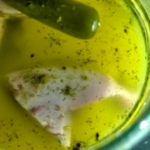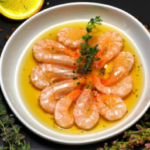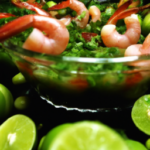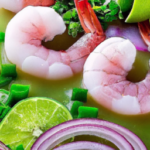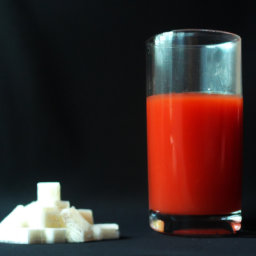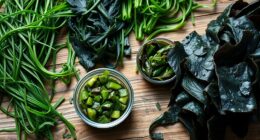Delicious, tempting, and enhanced with lime – that’s how I would describe the best steak marinade. Lime juice adds a juicy, flavorful kick to different meat dishes, with steak being a great example. But achieving the ideal balance of taste and tenderness in your steak depends on how long you marinate it in lime juice, a crucial factor for getting the right flavor and texture just perfect.
Marinating steak is a time-honored technique that can enhance the tenderness, juiciness, and flavor of the meat. Lime juice, in particular, has several benefits when used as a marinade. Its acidity can break down the tough muscle fibers in the steak, making it easier to chew. Lime juice also adds a bright, refreshing flavor that can complement the rich, savory taste of steak.
But like any culinary technique, marinating steak in lime juice requires some knowledge and practice to get it right. In this article, Ill explore the science behind marinating, the ideal duration for marinating steak in lime juice, and some tips on how to avoid over-marinating.
Key Takeaways
- Marinating steak with lime juice can enhance tenderness, juiciness, and flavor.
- Recommended marinating time is at least 30 minutes to an hour, but it can vary depending on meat thickness and desired flavor intensity.
- Over-marinating can break down meat fibers and make steak mushy, and marinating time should not exceed two hours due to lime juice’s high acidity.
- Balancing the flavors in the marinade is important when adding spices and herbs, and it’s recommended to use sirloin or flank steak for marinating as they are more absorbent.
The Benefits of Marinating Steak
You’re going to love how marinating steak in lime juice not only enhances the flavor, but also tenderizes the meat for an even more juicy and satisfying meal. Marinating techniques have been used for centuries to add flavor and tenderness to meats, and lime juice has become one of the most popular marinade ingredients in recent years.
Its acidity helps to break down the tough fibers in meat, resulting in a more tender and flavorful dish. In addition to tenderizing the meat, marinating steak in lime juice also adds a tangy and refreshing flavor that pairs well with a variety of foods.
You can add other ingredients to the marinade, such as garlic, herbs, or spices, to customize the flavor to your liking. Overall, marinating steak in lime juice is a simple and delicious way to elevate your next meal.
Now, let’s dive into the science behind marinating and why it works so well.
The Science Behind Marinating
I’d like to delve deeper into the science behind marinating and explore acidity’s crucial role in it.
For instance, lime juice is a popular choice for marinades because of its high acid content, which helps to tenderize meat.
However, the duration of marination can vary depending on factors like the meat’s thickness and the marinade’s ingredients.
Acidity’s Role in Marinating
The tartness of lime juice, like a burst of sunshine on a cloudy day, can tenderize and infuse flavor into steak during marination. Acidic marinades are known to break down the tough fibers in meat, making it more tender and juicy. Lime juice, being a highly acidic ingredient, can penetrate deep into the meat and create a chemical reaction that transforms its texture and taste.
To paint a picture in your mind, imagine the following scenarios when marinating steak with lime juice:
-
The juice of lime intermingling with the aroma of garlic and spices, creating an explosion of flavors that’ll leave you wanting more.
-
The vibrant green color of the marinade contrasting with the rich, deep red of the steak, making it look more appetizing and visually pleasing.
-
The acidic tang of lime breaking down the proteins in the meat, making it more tender and succulent than ever before.
-
The zesty, refreshing taste of lime infusing the meat with a tropical twist, taking your taste buds on a culinary journey to a far-off land.
With the knowledge of how acidic marinades and flavor profiles work, it’s time to delve deeper into how lime juice affects meat during the marination process.
How Lime Juice Affects Meat
Imagine sinking your teeth into a succulent piece of meat that’s been transformed by the zesty, tangy flavor of lime, leaving you craving for more.
Lime juice is a popular ingredient in many marinades because of its ability to tenderize meat. The acid in lime juice breaks down the muscle fibers, making the meat softer and more tender. Aside from tenderizing, lime juice also adds a refreshing citrus flavor that pairs well with beef, chicken, and fish.
It’s a great ingredient to use when marinating tough cuts of meat, such as flank or skirt steak. There are many variations of lime juice marinade recipes, but the best ones usually include a balance of acid, salt, and sweetness. Some popular ingredients to mix with lime juice are garlic, honey, chili flakes, and cumin.
When it comes to marinating, there are many factors that affect the time needed for the meat to absorb the flavors. These include the type of meat, its thickness, and the strength of the marinade.
Let’s delve deeper into these factors and learn how to achieve the perfect marinated meat.
Factors That Affect Marinating Time
Achieving perfectly marinated meat involves considering several factors such as the cut of meat, its thickness, and the strength of the marinade. These factors affect how long you should marinate your steak to achieve the desired results. Here are some factors that affect marinating time and recommended times for different cuts of steak:
-
Type of Meat
-
Tougher cuts of meat, such as flank steak and skirt steak, require longer marinating times to break down the fibers and tenderize the meat.
-
Tender cuts of meat, such as filet mignon and ribeye, only need to be marinated for a short period of time to enhance their natural flavors.
-
Thickness of Meat
-
The thicker the cut of meat, the longer it will take for the marinade to penetrate through the meat.
-
A steak that is less than 1 inch thick will only need to be marinated for 30 minutes to an hour, while a steak that is 1 ½ inches thick will require 2-3 hours of marinating time.
Knowing these factors will help you determine how long to marinate your steak to achieve the best results. In the next section, we’ll discuss how long you can marinate steak in lime juice and its effects on the meat.
How Long to Marinate Steak in Lime Juice
When it comes to marinating steak in lime juice, there are a few factors that can affect the marinating time. These include the cut of steak, thickness, and desired level of flavor intensity.
As a general rule of thumb, it’s recommended to marinate steak for at least 30 minutes to an hour, but certain cuts may require longer marinating times.
In this discussion, I’ll delve deeper into the factors that affect marinating time and provide recommended marinating times for different cuts of steak.
Factors That Affect Marinating Time
One key factor that affects marinating time is the acidity level of the marinade. When using lime juice as a marinade, it’s important to consider the acidity level of the lime juice in relation to the type of meat being marinated.
For example, delicate cuts of meat such as fish and chicken may need a shorter marinating time because they can become overcooked and tough if left in the lime juice for too long. On the other hand, tougher cuts of meat such as beef may require a longer marinating time to break down the fibers and make them more tender.
Other factors to consider when determining marinating time include the thickness of the meat, the desired level of flavor, and the temperature at which the meat will be cooked. Thicker cuts of meat will require a longer marinating time to ensure that the flavors penetrate the meat fully.
Additionally, if a stronger flavor is desired, the meat can be left in the marinade for a longer period of time. However, if the meat is going to be cooked at a high temperature, a shorter marinating time is recommended to prevent the meat from becoming too acidic.
With these factors in mind, it’s important to experiment with different marinating times to find the perfect balance for your desired flavor and texture. Recommended marinating times for different cuts of steak will be discussed in the subsequent section.
It’s important to note that the recommended times are just guidelines and it’s always best to check the meat periodically to ensure that it’s not becoming too acidic or tough.
Recommended Marinating Times for Different Cuts of Steak
To obtain the perfect flavor and texture, it is essential to consider the recommended marinating times for different cuts of steak based on their thickness and tenderness. Marinating can enhance the flavor and tenderness of lean and fatty cuts of steak, but the marinating time varies depending on the cut.
For lean cuts, such as sirloin and flank steak, marinating for at least 30 minutes up to 2 hours is recommended. Marinating for too long can break down the meat fibers and make the steak mushy. On the other hand, fatty cuts, like ribeye and skirt steak, can be marinated for 2 to 4 hours or even overnight. The fat content in these cuts can withstand longer marinating times without losing their texture or becoming mushy.
| Cut | Thickness | Marinating Time |
|---|---|---|
| Sirloin | 1 inch | 30 min – 2 hrs |
| Flank | 1 inch | 30 min – 2 hrs |
| Ribeye | 1 inch | 2 – 4 hrs or overnight |
| Skirt | 1/2 inch | 2 – 4 hrs or overnight |
To avoid over-marinating, it’s important to always follow the recommended marinating times and not exceed them. Over-marinating can result in the steak becoming too acidic or mushy. It’s also important to never reuse the marinade that has been in contact with raw meat to prevent foodborne illnesses.
Tips for Avoiding Over-Marinating
Make sure you don’t ruin your steak by over-marinating it with these helpful tips! One of the biggest mistakes people make when marinating steak is leaving it in the marinade for too long.
While marinating can add flavor and tenderness to your steak, leaving it in the marinade for too long can actually have the opposite effect. The acidity in the marinade can break down the proteins in the meat, resulting in a mushy, unappetizing texture.
To avoid over-marinating, it’s best to follow some simple best practices. First, always check the recommended marinating time for your specific cut of steak. Different cuts of steak require different marinating times, so it’s important to do your research.
Additionally, avoid using overly acidic ingredients in your marinade, like vinegar or citrus juice, as they can break down the meat too quickly. And finally, make sure to remove the steak from the marinade at the appropriate time and pat it dry before cooking.
With these helpful tips, you can ensure that your steak is perfectly marinated without being over-marinated. Next up, let’s explore different ways to use lime juice in marinades.
Different Ways to Use Lime Juice in Marinades
I love experimenting with different ways to use lime juice in my marinades. One trick I’ve found is to combine lime juice with other acids, like vinegar or wine, to create a more complex flavor profile.
Another option is to add a variety of spices and herbs, such as garlic, cumin, and cilantro, to give the marinade a kick.
And finally, a lesser-known technique is to use lime juice in a brine, which can help tenderize the meat and infuse it with flavor.
Trust me, these tips’ll take your marinades to the next level.
Combining Lime Juice with Other Acids
While lime juice on its own can be a great marinade for steak, combining it with other acidic ingredients like vinegar or wine can enhance the flavor even further. Here are some benefits and drawbacks of using different acid options in combination with lime juice:
| Acid Option | Benefits | Drawbacks |
|---|---|---|
| Vinegar | Adds a tangy flavor, tenderizes meat | Can be overpowering if used in excess |
| Wine | Adds a complex flavor, tenderizes meat | Can be expensive and may not be readily available |
| Lemon Juice | Adds a bright, citrusy flavor | Can be too acidic and overpowering if used in excess |
| Yogurt | Adds a creamy texture and tangy flavor | Can be too thick and may not work well with certain dishes |
| Buttermilk | Tenderizes meat and adds a tangy flavor | Can be too thin and may not work well with certain dishes |
It’s important to remember that the amount and type of acid used in a marinade can greatly impact the flavor of your steak. Experiment with different combinations to find the perfect balance for your taste buds. And don’t forget to add some spices and herbs to take your marinade to the next level!
Adding Spices and Herbs
Adding spices and herbs to your marinade can bring a burst of flavor and aroma to your meat. It’s important to choose the right combination of ingredients to enhance the natural flavors of the meat. Here are three tips to make your marinade stand out:
-
Using fresh vs. dried herbs in marinades – Fresh herbs have a more intense flavor and aroma than dried herbs. However, they can be more expensive and have a shorter shelf life. Dried herbs are more convenient, but they don’t have the same potency as fresh herbs. If using dried herbs, be sure to crush them between your fingers to release their oils.
-
Experimenting with different spice blends in marinades – Don’t be afraid to try different spice blends to create a unique flavor profile. For example, a blend of cumin, chili powder, and smoked paprika can add a smoky and spicy flavor to your steak. Or, try a blend of coriander, garlic, and ginger for an Asian-inspired marinade.
-
Balancing the flavors in your marinade – When adding spices and herbs, it’s important to balance the flavors so one doesn’t overpower the others. Taste the marinade before adding the meat and adjust the seasoning as needed.
Using these tips can elevate your marinade game and take your steak to the next level. In the next section, we’ll discuss using lime juice in a brine to tenderize the meat.
Using Lime Juice in a Brine
Who knew that a secret to tenderizing meat could be found in a citrusy brine? When it comes to marinating steak, lime juice can be a game changer. Not only does it add a zesty flavor, but it also helps break down the tough fibers in the meat, resulting in a more tender and flavorful steak.
But what if you don’t have lime juice on hand or you’re looking for a different flavor profile? Fear not, there are plenty of lime juice alternatives that can be used in a brine. Lemon juice, orange juice, and even grapefruit juice can all be substituted for lime juice in a brine. Each of these fruits contains natural acids that can help tenderize meat, making them great options for a citrusy brine. Additionally, the benefits of using lime juice in a brine extend beyond just tenderizing the meat. The acidity in the lime juice can also help enhance the flavors of any herbs or spices used in the brine, resulting in a more flavorful and well-rounded steak.
When it comes to preparing steak for marinating, the key to success is to choose the right cut of meat. Now that we’ve explored the benefits of using lime juice in a brine, let’s dive into the best cuts of steak to use for marinating.
Preparing Steak for Marinating
When I’m preparing steak for marinating, I always make sure to choose the right cut of meat. A leaner cut, like sirloin or flank steak, works well as they’re more absorbent.
I also like to cut the meat into thinner strips or cubes to enhance marination. Finally, I puncture the meat with a fork to allow the marinade to penetrate deeper into the meat, resulting in a more flavorful and tender steak.
Choosing the Right Cut of Steak
To get the best results, you should choose a cut of steak that’s suitable for marinating with lime juice. Here are three things to consider when selecting your steak:
-
Thickness: A thicker cut of steak will hold up better to marinating and grilling. Look for cuts like ribeye or strip steak that are at least 1 inch thick.
-
Marbling: The fat in the steak will add flavor and tenderness to the meat. Look for cuts with visible marbling throughout the steak.
-
Bone-in or boneless: Bone-in steaks will take longer to cook, but they also have more flavor. Boneless steaks are easier to slice and serve.
With these three factors in mind, you can choose a steak that’ll be perfect for marinating with lime juice and grilling to perfection. Once you’ve selected your steak, it’s time to move on to the next step of cutting the meat to enhance marination.
Cutting the Meat to Enhance Marination
Get ready to level up your grilling game by enhancing the flavor of your steak with some expert cutting techniques. Before marinating your steak in lime juice, score the surface of the meat in a criss-cross pattern to encourage the marinade to penetrate deeper into the fibers.
This technique allows the marinade to infuse more effectively into the steak, giving it a tender and succulent texture with a zesty citrus flavor. Scoring the steak not only enhances the marinade infusion but also creates a beautiful presentation when cooked.
When performing this cutting technique, be sure not to cut too deeply into the meat, as this could cause it to lose its juices during grilling. With this simple yet effective trick, you’ll be able to take your steak dish to the next level by adding depth and flavor to your meat.
Now, let’s move on to another technique for puncturing the meat to allow the marinade to penetrate even further.
Puncturing the Meat to Allow Marinade to Penetrate
Enhance the flavor and tenderness of your meat by puncturing it with a fork or meat tenderizer to allow the marinade to penetrate deeply. Puncturing techniques vary from making small holes with a fork to using a meat tenderizer to create tiny incisions. These techniques help break down the fibers of the meat, allowing the marinade to seep inside and infuse its flavors.
However, there are some risks involved when submerging meat in lime juice for too long. Lime juice is highly acidic and can start to "cook"the meat, resulting in a tougher texture. It is recommended to marinate beef for no more than two hours in lime juice. If you prefer to marinate for longer periods, consider using alternative acid options such as vinegar or lemon juice. These acids have a milder flavor and are less likely to overpower the natural flavor of the meat.
To ensure optimal flavor and texture when marinating your steak, there are a few tips to keep in mind. These include using a non-reactive container to avoid any metallic taste in the marinade, refrigerating the meat while it marinates, and allowing it to come to room temperature before grilling or cooking. By following these simple steps, you can create a delicious and tender steak that is sure to impress.
Marinating Tips for Optimal Flavor and Texture
You’re missing out on the most tender and flavorful steak imaginable if you don’t take the time to marinate it with a few simple tricks. Marinating techniques and flavor combinations can elevate your steak to a whole new level.
A simple marinade of lime juice, olive oil, and garlic can add a zesty kick to your meat, while a mixture of soy sauce, brown sugar, and ginger can give it a sweet and savory flavor. But be careful not to overdo it with the lime juice. While it can add a refreshing twist to your steak, marinating for more than 24 hours could turn your meat into a puck-like rubbery mess!
It’s best to marinate your steak for at least 30 minutes to an hour, depending on the thickness of your cut. Once marinated, pat your steak dry with paper towels before cooking to ensure a nice sear. Speaking of cooking, let’s move onto the next section and explore the best ways to cook your marinated steak.
Cooking Marinated Steak
When I’m cooking marinated steak, there are three key points I keep in mind:
-
Removing excess marinade is crucial to prevent the steak from becoming too soggy or over-seasoned.
-
Next, I prepare the grill or pan by preheating it to the right temperature and brushing it with oil to prevent sticking.
-
Finally, I cook the steak to the desired temperature, using a meat thermometer to ensure it’s cooked to perfection.
By following these steps, I’m able to create a delicious and perfectly cooked marinated steak.
Removing Excess Marinade
Don’t panic if you see too much marinade on your steak before cooking. Just use a paper towel to gently remove the excess, and you’ll be good to go – no need to waste that flavorful lime juice goodness! Removing excess marinade is crucial to achieving a perfectly cooked steak.
Here are some tips and tools to help you remove excess marinade:
-
Use a paper towel: The easiest and most accessible tool you can use to remove excess marinade is a paper towel. Simply pat the steak with a paper towel until the excess liquid is absorbed.
-
Use a colander: If you have time, place the marinated steak in a colander over a bowl and let the excess marinade drip off for a few minutes.
-
Use a brush: If you’re worried about losing too much flavor, use a silicone brush to brush off the excess marinade instead of wiping it off.
Now that you know how to remove excess marinade, it’s time to prepare the grill or pan for cooking.
Preparing the Grill or Pan
Now that we’ve removed the excess marinade from our steak, it’s time to prepare our grill or pan. I prefer to use a grill to get those beautiful grill marks on my steak, but a pan on the stove works just as well.
If using a grill, preheat it to medium-high heat. The ideal temperature for grilling steak is between 350-450°F. If using a pan, heat it over medium-high heat until it’s hot enough to sear the steak.
While waiting for the grill or pan to heat up, you can start thinking about seasoning options. Salt and pepper are classic choices, but you can also experiment with different rubs or marinades. Just be careful not to over-season as the lime juice marinade will already add a lot of flavor to the steak.
Once your grill or pan is hot and ready, it’s time to move on to cooking the steak to your desired temperature.
(Note: It’s important to note that cooking time will vary depending on the thickness of your steak and your desired level of doneness. We’ll discuss this in the next section about cooking to the desired temperature.)
Cooking to the Desired Temperature
To get that perfect steak, it’s crucial to cook it to your desired temperature. There are several cooking techniques you can use, such as grilling, pan-searing, or broiling. The key is to ensure that the heat is evenly distributed and that the steak is cooked to your liking.
When cooking steak, it’s important to consider the quality of the meat. A good quality steak will have a higher fat content, which will help keep it moist and tender during cooking. Additionally, the thickness of the steak will also affect the cooking time and temperature. Thicker cuts will require a lower temperature and longer cooking time, while thinner cuts will cook faster at a higher temperature.
By taking these factors into consideration, you can ensure that your steak is cooked to perfection every time.
Now that we’ve covered cooking to the desired temperature, let’s move on to serving marinated steak.
Serving Marinated Steak
When I serve marinated steak, I always keep it simple. I love letting the flavors of the marinade stand out, and I find that adding additional seasonings or sauces can sometimes detract from the delicious taste of the meat.
However, that doesn’t mean that serving marinated steak has to be boring! There are plenty of creative serving ideas that can elevate your meal and make it feel special.
One of my favorite ways to serve marinated steak is to slice it thinly and arrange it on a platter with some fresh herbs and sliced vegetables. This makes for a beautiful presentation, and it also allows guests to customize their own plates by choosing the ingredients they like best.
Another great option is to serve the steak on a bed of greens, either as a salad or as a warm dish with wilted spinach or kale.
And of course, don’t forget about the sides! The best sides to pair with marinated steak are ones that complement the flavors of the marinade and add some variety to the meal. Some of my go-to options include roasted vegetables, mashed sweet potatoes, or a simple rice pilaf.
Frequently Asked Questions
Can you marinate steak in lime juice overnight?
Marinating steak in lime juice overnight can enhance its flavor and tenderness. To achieve the best taste, use fresh lime juice and add other spices. Remember, marinating for too long can turn the steak mushy.
Is it safe to consume raw marinated steak?
Raw marinated steak can be unsafe due to the risk of bacterial contamination. Consider using alternative marinades such as vinegar or citrus-based options that are cooked before consumption to ensure safety.
Can I use bottled lime juice instead of fresh lime juice for marinating steak?
In my opinion, fresh lime juice is better for marinating steak as it contains more natural enzymes that tenderize the meat. However, bottled lime juice can still be used. Both types of lime juice can effectively flavor the steak.
Can I reuse leftover marinade from marinating steak in lime juice?
Did you know that on average, Americans eat over 55 pounds of beef per year? As for using leftover marinade, it’s not recommended due to bacteria growth. Consider alternative marinades like soy sauce or vinegar.
Can I freeze marinated steak in lime juice for future use?
Yes, you can freeze marinated steak in lime juice for future use, but the texture and flavor may be affected. Consider using alternative citrus juices like lemon or orange. Always thaw properly before cooking.
Conclusion
So there you have it, folks! Marinating your steak in lime juice can be a game changer for your taste buds. Whether you’re grilling, broiling, or pan-frying, a little bit of lime juice can go a long way in enhancing the flavors of your steak.
The tangy, citrusy flavor of lime juice adds a refreshing twist to the meat, making it a perfect summer dish. As you marinate your steak in lime juice, you can imagine yourself lounging on a tropical island, sipping on a cold margarita while enjoying the warm sun and the ocean breeze.
The aroma of the lime juice and the sizzling sound of the steak on the grill will transport you to a place of relaxation and indulgence. So go ahead, try marinating your steak in lime juice and see for yourself how it can elevate your dining experience.
Ilana has been a vegan for over 10 years. She originally made the switch for health reasons, but soon found herself becoming more and more passionate about the ethical and environmental implications of a vegan lifestyle. Ilana is the author of The Graceful Kitchen, a blog all about veganism. She loves to cook up delicious and nutritious vegan meals, and share her recipes with others who are interested in leading a cruelty-free life. Ilana is also a strong advocate for using whole foods as the foundation of a healthy diet, and believes that going vegan is one of the best ways to achieve this.



